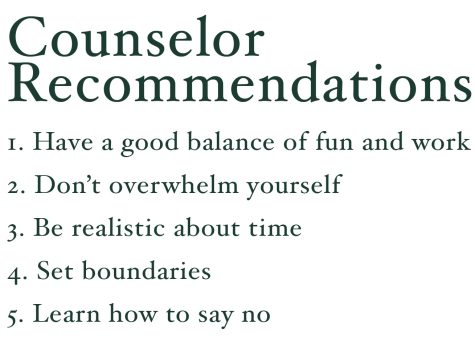Tick tock: Time management plays important role in student lives
Time management is the act of organizing and allotting your time to different activities in order to optimize the 24 hours that are given in a day. A study from Princeton University found that adopting small habits such as having a routine, having an organized environment, and properly planning out your schedule are important keys to integrating good time management into a daily ritual.
November 18, 2021
When Tanya Karpinchyk (10) started in-person school this year, an overload of homework suddenly hit her, leading to procrastination and unprecedented levels of stress. Although the need to quickly adapt to a new setting overwhelmed her, Tanya relied on positive studying habits to ease the transition. Prioritizing time management and using the Pomodoro method helped her to grow accustomed to the new experience of in-person learning at the high school level.
According to the Cambridge Dictionary, time management is “the practice of using the time that you have available in a useful and effective way, especially in your work.”
A study from Princeton University found that adopting small habits such as creating a routine, having an organized environment and properly planning out your schedule are important keys to integrating good time management into a daily ritual. Princeton University also states that time management can be used as a visual aid to determine if the amount of commitments that one has is too much, too little or just the right amount, especially for high school students.
Using materials such as a planner or online schedule list can help students lay out all the tasks that they need to get done in a day and how much time must be put in to complete the task well. With the variety of courses and extracurriculars available to students, it’s important to recognize that not every class can be taken, and not every sport can be played. This means that students must choose what they want to participate in during the school year carefully to maximize the use of their time, while also enjoying the activities they are doing.
Upper school academic dean Kelly Horan sympathizes with students about the pressures of high school and peers and offers advice on how to determine one’s course load.
“[It’s] always hard to choose the right courses, whatever the right courses mean, because kids have different aptitudes at different things, and so what could take you 15 minutes to do the homework could take me an hour and a half,” Horan said. “If students are realistic about their aptitudes and things that challenge them and where they put their time, I think it can all work quite nicely.”

In order to help guide a high school student to success, it ultimately also lies within the accountability of the student to carry out these responsibilities. From personal trials and tribulations, Tanya has begun to understand how learning to manage time well can reduce stress levels, factoring in time-consuming activities that did not exist while in remote learning.
“I’ve had experience in the past where I didn’t do my work in time, and it’ll just kind of end up crashing on me,” Tanya said. “It motivates me to time manage and spread out everything just so I [can]open up gaps for things like extracurriculars or spending time with friends.”
As students traverse further and further into the school year, upper school counselor hopes that students will begin to adjust to their old schedules of extracurricular activities and wake up earlier. Though the changes may differ between people, Schreiman hopes each person can settle into a routine that works best for them, filled with doing things that they enjoy.
“I would say find the thing that you love, that really speaks to you, and then do that,” Schreiman said. “It’s totally worth all of those hours because that’s going to feed your soul and that’s going to make you really happy. But then do three other things with it…and you’re not going to really be able to really enjoy the experience and put that time in.”
Not only do teachers feel as though students should prioritize what they believe is of higher importance, but students themselves are also becoming aware of the shifting changes and also are growing accustomed to them.
“Now it’s definitely more difficult because there are so many other things you have to account for even the commute to school,” Tanya said. “That’s also more time that’s taken away from you, and everything is a lot more tiring because it gets hard coming back to in-person learning. But with time managing, it is just kind of adjusting to everything you have, and I definitely started using my calendar a bit more and making sure I write everything down that I’m going to do.”
Schreiman also advises students to choose a schedule and activities that satisfy them, rather than a class that they feel pressured to take due to parents or peers around them. She recommends sitting down and reflecting upon other daily responsibilities such as getting enough sleep, saving time for commuting and staying mentally healthy.
“We can just take a pause, and we can reflect on what we’re doing,” Schreiman said. “Then we can recognize, like, ‘oh, I am only getting six hours of sleep, that’s really not adequate for me and then see where can I make those adjustments.’”
Despite the number of courses or extracurriculars a student may have packed into their schedule, a day still only has 24 hours. With improving time management and resources such as planners, students can utilize the available help in order to get the most out of their day.


















![“[Building nerf blasters] became this outlet of creativity for me that hasn't been matched by anything else. The process [of] making a build complete to your desire is such a painstakingly difficult process, but I've had to learn from [the skills needed from] soldering to proper painting. There's so many different options for everything, if you think about it, it exists. The best part is [that] if it doesn't exist, you can build it yourself," Ishaan Parate said.](https://harkeraquila.com/wp-content/uploads/2022/08/DSC_8149-900x604.jpg)




![“When I came into high school, I was ready to be a follower. But DECA was a game changer for me. It helped me overcome my fear of public speaking, and it's played such a major role in who I've become today. To be able to successfully lead a chapter of 150 students, an officer team and be one of the upperclassmen I once really admired is something I'm [really] proud of,” Anvitha Tummala ('21) said.](https://harkeraquila.com/wp-content/uploads/2021/07/Screen-Shot-2021-07-25-at-9.50.05-AM-900x594.png)







![“I think getting up in the morning and having a sense of purpose [is exciting]. I think without a certain amount of drive, life is kind of obsolete and mundane, and I think having that every single day is what makes each day unique and kind of makes life exciting,” Neymika Jain (12) said.](https://harkeraquila.com/wp-content/uploads/2017/06/Screen-Shot-2017-06-03-at-4.54.16-PM.png)








![“My slogan is ‘slow feet, don’t eat, and I’m hungry.’ You need to run fast to get where you are–you aren't going to get those championships if you aren't fast,” Angel Cervantes (12) said. “I want to do well in school on my tests and in track and win championships for my team. I live by that, [and] I can do that anywhere: in the classroom or on the field.”](https://harkeraquila.com/wp-content/uploads/2018/06/DSC5146-900x601.jpg)
![“[Volleyball has] taught me how to fall correctly, and another thing it taught is that you don’t have to be the best at something to be good at it. If you just hit the ball in a smart way, then it still scores points and you’re good at it. You could be a background player and still make a much bigger impact on the team than you would think,” Anya Gert (’20) said.](https://harkeraquila.com/wp-content/uploads/2020/06/AnnaGert_JinTuan_HoHPhotoEdited-600x900.jpeg)

![“I'm not nearly there yet, but [my confidence has] definitely been getting better since I was pretty shy and timid coming into Harker my freshman year. I know that there's a lot of people that are really confident in what they do, and I really admire them. Everyone's so driven and that has really pushed me to kind of try to find my own place in high school and be more confident,” Alyssa Huang (’20) said.](https://harkeraquila.com/wp-content/uploads/2020/06/AlyssaHuang_EmilyChen_HoHPhoto-900x749.jpeg)












